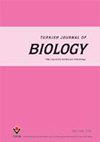Ampicillin activates Mpk1 phosphorylation in Saccharomyces cerevisiaeand ERK1/2 phosphorylation in HepG2 cells
IF 0.9
4区 生物学
Q3 BIOLOGY
引用次数: 0
Abstract
Ampicillin has been widely used to treat bacterial infections. When we used ampicillin to eliminate bacterial contamination in yeast cultures, we observed induction of phosphorylation of MAP kinase 1 (Mpk1), a previously unknown function of ampicillin. We therefore investigated whether ampicillin activates the signal transduction pathway. Phosphorylation of Saccharomyces cerevisiae Mpk1 was induced by ampicillin in a dose- and time-dependent manner through the PKC1-CWI pathway. Mpk1 phosphorylation was maximal after treatment with 3 mM ampicillin for 90 min. Despite activation of Mpk1 phosphorylation, ampicillin did not influence yeast cell growth. Ampicillin reduced miconazole antifungal activity; miconazole had a minimum inhibitory concentration of 3.125 µg/mL against Candida albicans, which increased to 25 µg/mL after 48 h of treatment with 3 mM ampicillin. Finally, ampicillin activated phosphorylation of ERK1/2 (a mammalian homolog of Mpk1), with maximum effect at 3 mM ampicillin, in human HepG2 cells, but did not influence cell viability. The results of this study clearly indicate that ampicillin activated Mpk1 phosphorylation in yeast and ERK1/2 phosphorylation in HepG2 cells. In addition to its clinical application to eliminate bacteria, ampicillin could also be used to activate Mpk1 or ERK1/2 in the laboratory.氨苄青霉素激活酿酒酵母Mpk1磷酸化和HepG2细胞ERK1/2磷酸化
氨苄青霉素已被广泛用于治疗细菌感染。当我们使用氨苄青霉素消除酵母培养物中的细菌污染时,我们观察到MAP激酶1(Mpk1)的磷酸化诱导,这是氨苄青霉素以前未知的功能。因此,我们研究了氨苄青霉素是否激活信号转导途径。氨苄青霉素通过PKC1-CWI途径以剂量和时间依赖的方式诱导酿酒酵母Mpk1磷酸化。用3mM氨苄青霉素处理90分钟后,Mpk1磷酸化最大。尽管Mpk1磷酸化被激活,但氨苄青霉素不影响酵母细胞生长。氨苄青霉素降低了咪康唑的抗真菌活性;咪康唑对白色念珠菌的最低抑制浓度为3.125µg/mL,用3mM氨苄青霉素治疗48小时后,该浓度增至25µg/mL。最后,在人HepG2细胞中,氨苄青霉素激活ERK1/2(Mpk1的哺乳动物同源物)的磷酸化,在3mM氨苄青霉素时效果最大,但不影响细胞活力。该研究的结果清楚地表明,氨苄青霉素激活了酵母中的Mpk1磷酸化和HepG2细胞中的ERK1/2磷酸化。氨苄青霉素除了在临床上用于消灭细菌外,还可以在实验室中用于激活Mpk1或ERK1/2。
本文章由计算机程序翻译,如有差异,请以英文原文为准。
求助全文
约1分钟内获得全文
求助全文
来源期刊

Turkish Journal of Biology
BIOLOGY-
CiteScore
4.60
自引率
0.00%
发文量
20
审稿时长
6-12 weeks
期刊介绍:
The Turkish Journal of Biology is published electronically 6 times a year by the Scientific and Technological
Research Council of Turkey (TÜBİTAK) and accepts English-language manuscripts concerning all kinds of biological
processes including biochemistry and biosynthesis, physiology and metabolism, molecular genetics, molecular biology,
genomics, proteomics, molecular farming, biotechnology/genetic transformation, nanobiotechnology, bioinformatics
and systems biology, cell and developmental biology, stem cell biology, and reproductive biology. Contribution is open
to researchers of all nationalities.
 求助内容:
求助内容: 应助结果提醒方式:
应助结果提醒方式:


